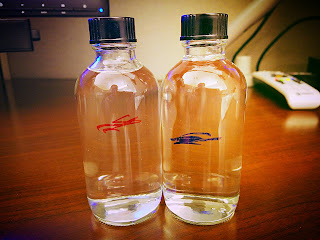The
Garagiste Festival is coming to Paso Robles in November, so save the date. The event features boutique wineries, small producers, with some extremely great California wine to pour for you. The festival's "Urban Exposure" was held recently in Santa Monica, and I was delighted to accept their invitation to attend.
Garagiste, in case you are wondering, is a French term (gar-uh-zhee-stuh) which originated in Bordeaux. It described mavericky small-lot winemakers who didn't care much for following the rules. These passionate vintners often whipped up their wine in the garage, or whatever space they had available to them.
What was once just a pejorative is now a movement. Not that California winemakers operate under the burden of the sort of rules found in France, but these folks are considered renegades simply for daring to make their wine their way.
Nearly four dozen wineries which produce less than 1200 cases per year poured wines that people may not get a chance to taste very often. Most of these small producers don't have tasting rooms, and their distribution is often spotty, if not non-existent. I didn't get to taste from every table, by a long shot. Here are the wines I sampled.
Ann Albert Wines - Santa Barbara winemaker
Eric Johnson poured two first-vintage 2015 Chardonnays that both spoke to their origins. The one from Zotovich Vineyards in the Sta. Rita Hills had lemon-lime fruit aged in new French oak, $44. The one from Bien Nacido Vineyard showed the touch of earth and savory salinity I love so much from that farm, $44. He excitedly told me of the efforts of the Bien Nacido vineyard manager and crew that may have spared the vines from being damaged by a recent wildfire.
Brophy Clark Cellars - This Santa Barbara winery makes a 2014 Santa Maria Valley Chardonnay with restrained alcohol and just the right touch of new French oak, $22.
Burning Bench Cellars - A Marin County boutique producer, winemaker
David Mease poured a 2006 Pinot Noir from Moon Hill Vineyard that showed some lovely browning and savory tea notes. More recent vintages are big and fruity without knocking people down, $45.
Carucci Wines - Santa Barbara winemaker
Eric Carucci's 2013 Viognier from the Sanford and Benedict Vineyard has a big floral nose and a savory/fruity palate, $30. His 2014 Grenache comes from a lovely warm-weather site, Murmur Vineyard, located between Santa Maria and Los Alamos, $38.
Chenoweth Wines - Sonoma producers
Charlie and
Amy Chenoweth concentrate on Russian River Valley Pinot Noir that are big and fruity, $65.
Cholame Vineyard - This San Miguel winery has
Andres Ibarra making the 2014 Summer Shade Grenache Blanc, a standout at this event. Super salinity, super savory, huge nose and brilliant acidity, $24.
Coruce Vineyards - The Antelope Valley, north of Los Angeles, is not the first place one thinks of when Southern California wine regions are bandied about. Winemaker
Bob Balentine works magic with warm-climate estate grapes like Semillon and Symphony, $21, and Viognier, $25. Big florals mark these appealing whites.
D. Volk Wines -
Dana Volk was quick to point out that she's no relation to Santa Barbara County winemaker
Kenneth Volk. I think her actual words were "Yeah, I wish!" On her own, she has made some wines to be proud of. Her 2016 Camp 4 Vineyard Grenache Rosé is a savory beauty, $22. Her 2015 Duvarita Vineyard Pinot Noir is lovely and elegant, $42. Her 2014 Syrah from Hampton Family Vineyards is a great warm-climate version of the grape, $24.
Tao Vineyards -
Michael and
Nikki McRory say they actually do have a few grape-growing neighbors in Agoura Hills, just over the crestline from the Malibu AVA. Winemaker
B. Alan Geddes makes a 2016 Syrah Rosé that’s very good, $22; the 2015 Awakening Sangiovese that’s beefy, $26; and the amazing 2015 Mindful Merlot, that’s magic in a bottle, $38.
Theopolis Vineyards -
Theodora Lee has to wake up feeling like the Maytag repairman sometimes. She's a female, African-American winemaker in the Anderson Valley, and she plays that role to the hilt. "Now, don't you walk away without tasting my Petite Sirah. That's my baby!" But, she's also proud of her 2014 Pinot Noir, unfiltered and elegant, $42, She calls her richly-colored 2014 Rosé of Petite Sirah a "summer red," and it's a great one, $24. Her 2014 Symphony makes one realize what a cool climate can do for that grape, $22.
Two Shepherds - Sonoma winemaker
William Allen poured his 2014 Grenache Blanc from "down south," the Saarloos Vineyard in the Santa Ynez Valley. Graceful savory notes, $25. His 2016 Rosé of Grenache from Mendocino's Potter Valley is extremely pale and elegant, $25. The Two Shepherds 2014 Pastoral Melange Rhone Blend is an incredible North Coast mix of Mourvèdre, Carignane, Syrah and Roussanne. Unorthodox, but tasty. It’s light enough to take a chill well and would make a good BBQ wine, $24.
Vinemark Cellars - Thousand Oaks producer
Mark Wasserman uses mostly eastside Paso Robles grapes for his remarkable wines. His 2016 Chardonnay is beautifully oakless, $24. Another great pink wine at this event, the Vinemark 2016 Grenache Rosé is awesome, full and earthy, $24. He does a nice Cal-Italian turn with the 2015 five-grape Buono Miscela, $35, and the light and breezy 2014 Mezzanotte of Primitivo and Syrah, $32. He says his 2014 Cab is his best ever, and it has the mark of Paso Robles all over it. $32.
Follow Randy Fuller on Twitter


























